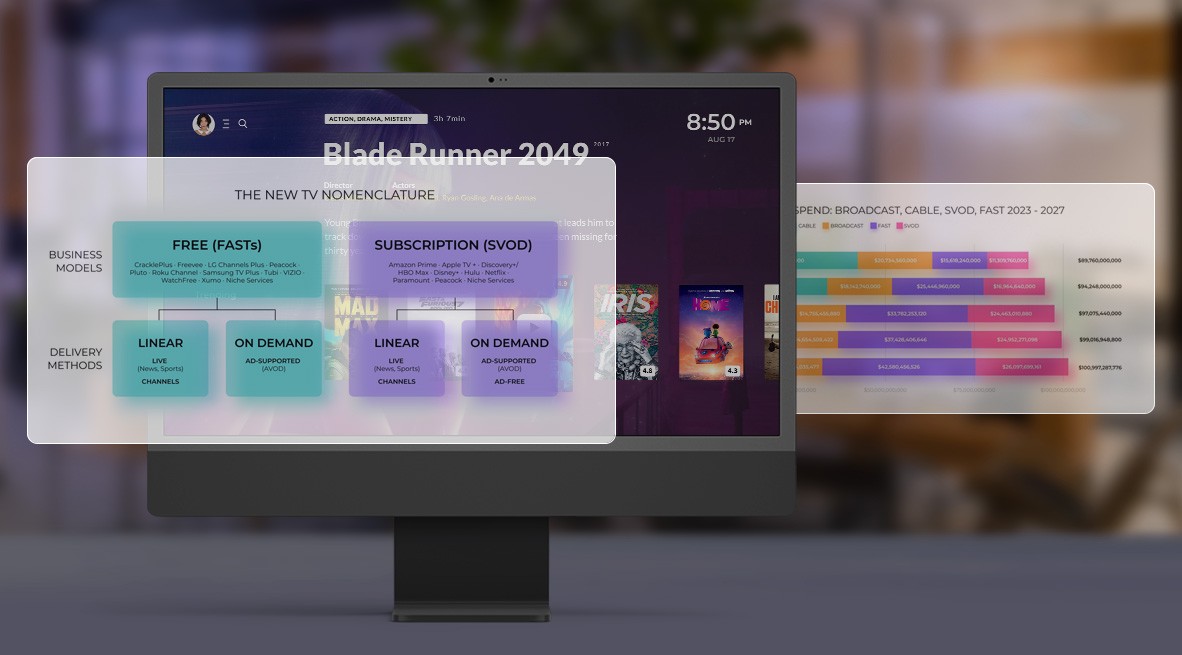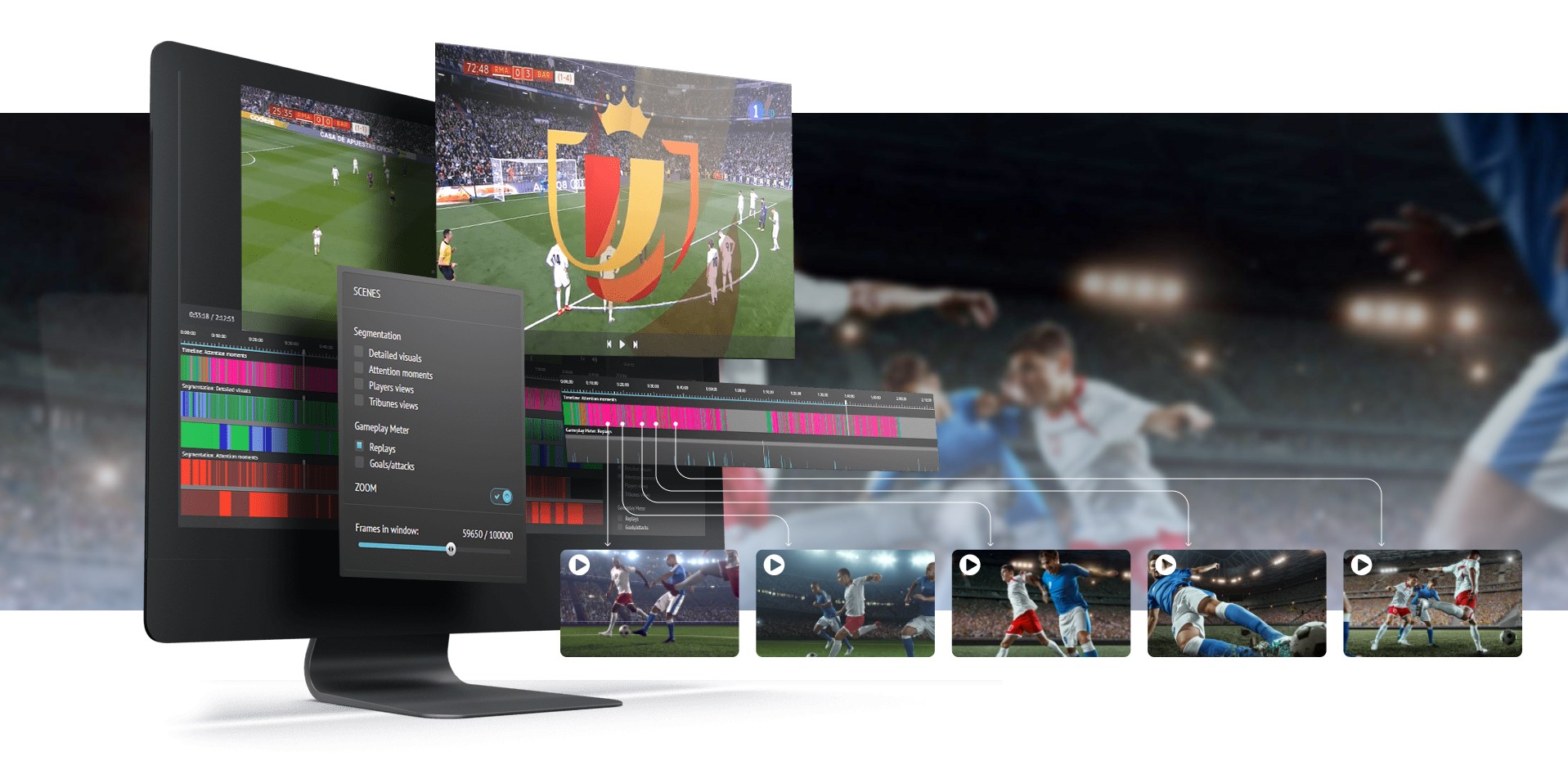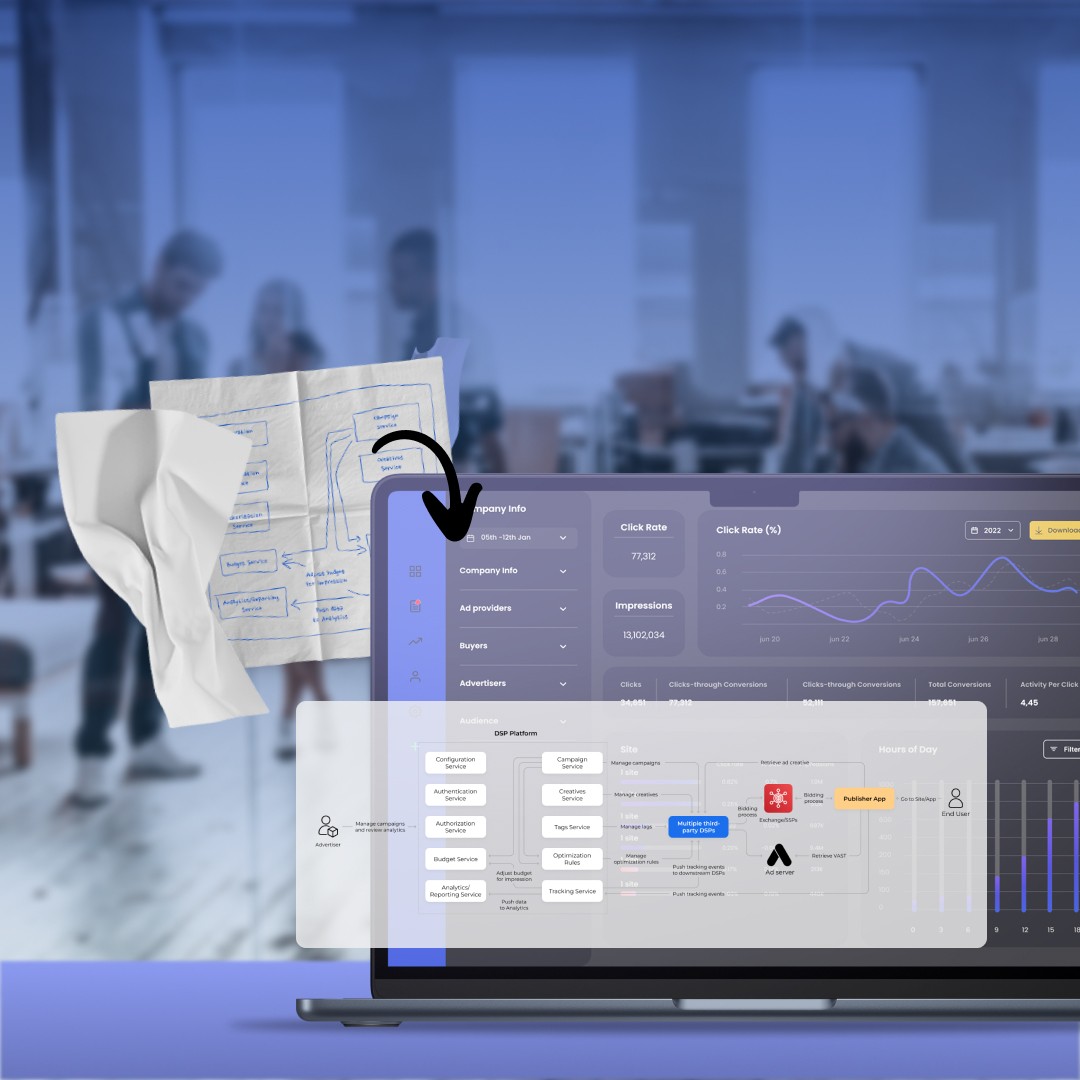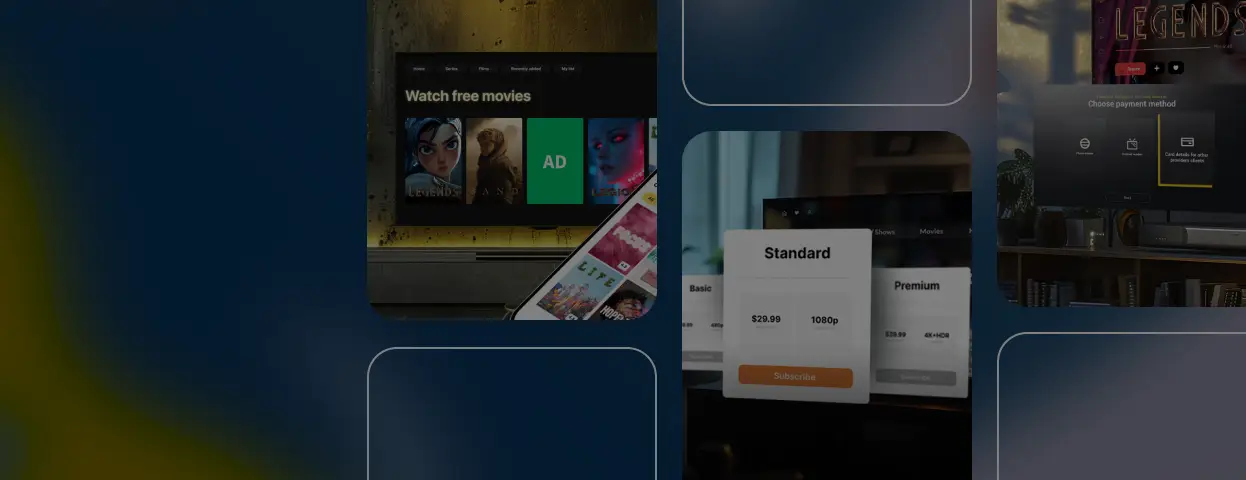Is FAST less prestigious than SVOD?
There’s this misconception that Free Ad-Supported Streaming Television (FAST) is considered by users as a non-premium option compared to commercial-free formats.
It’s not.
General fatigue from ubiquitous subscriptions to dozens of services and apps, the ability to passively enjoy content with no efforts wasted on making choices, and the absence of monthly cable TV bills — all this is too good for users to voluntarily tag it as “inferior”. Which is evidenced by the Deloitte study: almost 60% of households enjoy a free, ad-supported streaming video service nowadays.
However, it’s important to keep in mind that the flexibility of the on-demand format still makes it a strong competitor to FAST, which evidently lacks such flexibility.
That’s why the key to success for FAST services comes down to arming them with smart personalization in every possible aspect that will foster user satisfaction and loyalty.
This way, under precise audience analytics and segmentation, even the advertising beast disrupting the content, typically deemed as annoying, can become an ally for providers of free ad-supported TV services, contributing to positive user engagement.

In this article, we will explore the most current and practical aspects of personalizing FAST channels in two ways: by customizing the content stream itself and by tailoring the free ad-supported TV ads based on the data.
And if you’re wondering where we got all this FAST wisdom from — we gleaned major FAST insights from top industry events like IBC 2023, complemented by our two-decade experience in the video streaming industry and AdTech expertise.
Making content streams and ads align with user interests
Viewing the personalization of free ad-supported TV channels, separating content stream and advertising personalization, is rather ineffective, for they are typically intertwined and are very complementary to each other. Yet, in each segment, one can discern the following distinct strategies:
Personalizing ads: making them a fair trade for free content streams
With FAST being undeniably on the rise, advertisers are given an excellent opportunity to expand their reach and connect with the audience that was unreachable by conventional advertising channels. But as the demand for ad space on FAST channels increases, so do the expectations of the viewers for the ads. Let’s take a closer look at the components involved in the free ad-supported TV channel monetization process and things that make ads more tailored to their audience.
Dynamic ad insertion

While you can monetize FAST channels in different ways, Dynamic Ad Insertion (DAI) is a key technology that allows effective advertising on FAST channels and maximizes ad revenue for publishers. Making it truly smart and right on point depends on several elements:
- Creating accurate and comprehensive user profiles. Crafting precise and thorough user profiles that would enable intelligent ad insertion involves gathering and analyzing data from numerous channels. This encompasses details regarding the device in use, geographic and IP data, and additional insights from external sources like consumer data collection agencies. The collected data undergoes automated processing, transforming it into distinct and up-to-the-moment patterns of user behavior.
- Finding the right balance between the ad frequency, ad duration, and profits. Choosing technology solutions that enable providers to set ad frequency caps and strategically create ad breaks today is an indisputable prerequisite for the survival of FAST service. Most FAST platforms are adopting a reduced ad load strategy. They typically offer around 8 to 10 minutes of ads per hour, compared to traditional linear TV, which can run upwards of 16 minutes per hour. And certainly, the timing of ad placements should be appropriate, aligning the ad with the themes, topics, or sentiments of the content a user is watching.
- Having a reliable and scalable infrastructure. Even the most relevant and personalized ads can be irritating if they are not inserted smoothly and disrupt the video stream. So having a backend capable of supporting high-quality video delivery and ad stitching without buffering makes a lot of sense.
Ad formats
The formats of online video ads can vary depending on the platform, the content, and the audience. Yet, here are some of the ones you’ll come across most frequently:
- Pre-roll ads, effective for grabbing attention and building brand awareness.
- Mid-roll ads, akin to TV commercials, suitable for conveying a longer and more engaging message to an already invested viewer.
- Post-roll ads, useful for prompting viewers to take the next step, like visiting a website or making a purchase.
- Pause ads, whether static or dynamic, work well for catching the viewer’s attention when they’re most receptive.
On top of these formats, we’re seeing a growing shift towards interactive and shoppable ads, aiming to deliver a richer and more tailored experience. These ads leverage different elements like interactive scrollables, grids, polls, and more. According to Sprout Social, these ads have the potential to boost Click-Through Rates (CTR) by 47% and enhance brand recall by 32%.
Avoid hit-or-miss personalization
See how we collect and analyze viewer behavior data, recommend tailored content, and weave interactivity into video streaming, making it not only more enjoyable for the audience but also more lucrative for media and broadcasting businesses.
Personalizing content streams: making them worth watching ads
Since FAST tends to mimic the somewhat generic feel of traditional cable TV, which isn’t very captivating or tailored for viewers, the services that step up to fix this problem by adding a personal touch to linear content and enhancing it with interactive features clearly take the lead. Here’s how this can be achieved:
Personalized recommendations
The key to recommending content that users are likely to be interested in lies in analyzing a combination of viewer behavior, first-party data, and content metadata.
And the benefits? This engaging and more relevant viewing experience can keep viewers hooked for longer durations, contributing to an increase in the hours of view, lead to a boost in overall video consumption, and, ultimately, increase advertising revenue for the FAST service providers.
Personalization can effectively address another issue related to the scattered nature of live sports across different streaming platforms. Viewers often struggle to locate their favorite teams, players, and games in this scenario. A potential solution involves a collaboration between a streaming device and a sports league, creating a dedicated section (e.g., tennis) on the device’s home screen. This section not only helps viewers find where to watch matches based on their preferred streaming services but also offers additional tennis-related content like highlights, news, and analysis.
And the advantages? Such a user-friendly solution will not only simplify access to live sports but also enhance viewer engagement and loyalty.

Regional personalization
It’s truly heartening to spot on TV something familiar that vibes with your local scene. That’s why a strategy that customizes various versions of the same linear TV channel, depending on the viewers’ location and their interest in local sports teams and events, is bound to be a success.
In this scenario, viewers in different areas would receive content specifically tailored to their region while tuning into the same broadcast. Additionally, this approach facilitates targeted advertising aimed at different viewer groups based on their location and demographics.
And the perks? It can not only enhance the relevance and appeal of sports content for viewers but also open up more opportunities for regional sports networks to generate revenue through monetization and sponsorship.
How to boost ad revenue with FAST?
Explore our AdTech capabilities for enhancing your free ad-supported TV distribution strategies and maximize ad yield through our expertise in combating any challenge a publisher or AdTech software provider can face.
Generative AI for better personalization
Generative AI, touted as the standout trend of the year, holds the potential to individualize FAST channels in several ways:
- Creating customized programming schedules for each viewer, based on their preferences, behavior, and feedback. For example, a generative AI system could learn from the user’s viewing history and ratings and generate a personalized lineup of shows and movies that match their interests and mood.
- Ensuring ads perfectly align with the current content by analyzing contextual data quickly and dynamically adjusting to evolving and changing context.
- Identifying anomalies or deviations from the norm in data, including images and videos, serving as an effective mechanism for detecting potential security breaches or irregularities within FAST streams.
Generative AI can potentially revolutionize content personalization in FAST channels, as it can offer a more immersive and satisfying viewing experience for the user, and a more effective and profitable advertising strategy for the publisher. However, AI tools and technologies must be applied judiciously to avoid overwhelming or annoying the user or violating their privacy or preferences.
Sane personalization matters
Personalization is wonderful in its diversity, but also quite fickle. Therefore, when implementing it, it is very important to ensure that:
- Personalization does not go too shallow and loses its meaning, e.g., when a user watched an action movie last week and now, he is being offered only this genre.
- Recommendations are differentiated for multiple users within one household, applying more advanced analysis methods.
Expert vision in point
In a recent article for Digital TV Europe, our video solution system analyst, Alexey Zaberezhniy, delved into the complexities of gathering, processing, and analyzing viewer data to construct detailed user profiles, including the ones within one household, and shed light on the most effective strategies to overcome them.
Moreover, if you’re curious about the remarkable recommendations attainable through machine learning-based models and the time factor, we encourage you to explore his insights.

- Smart contextual analysis is used to find the right time for an ad, which should be of paramount importance. For instance, the advertisements of an airline should probably not appear in a scene with a plane crash. You can read more about why this is such a serious issue for FAST services, and what is needed for successful ad placement here.
If delving into all the steps and possibilities of personalization with articles sounds too time-consuming or simply isn’t your thing, our team of AdTech experts is here to address all your questions and concerns about tailored FAST TV services. With a wealth of project experience spanning numerous cases in video streaming and AdTech, we’re well-prepared to guide you on what it takes to ensure you don’t end up watching your competition pass you by in terms of personalized viewing experiences.


























